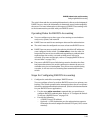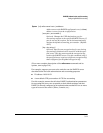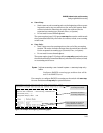
5-20
RADIUS Authentication and Accounting
Configuring RADIUS Accounting
– Optional—if you are also configuring the switch for RADIUS
authentication, and need a unique encryption key for use during
authentication sessions with the RADIUS server you are desig-
nating, configure a server-specific key. This key overrides the
global encryption key you can also configure on the switch, and
must match the encryption key used on the specified RADIUS
server. For more information, refer to the key < key-string > param-
eter on page 5-10. (Default: null)
2. Configure accounting types and the controls for sending reports to the
RADIUS server.
• Accounting types: exec (page 5-18), network (page 5-18), or system
(page 5-18)
• Trigger for sending accounting reports to a RADIUS server: At
session start and stop or only at session stop
3. (Optional) Configure session blocking and interim updating options
• Updating: Periodically update the accounting data for sessions-in-
progress
• Suppress accounting: Block the accounting session for any
unknown user with no username access to the switch
1. Configure the Switch To Access a RADIUS Server
Before you configure the actual accounting parameters, you should first
configure the switch to use a RADIUS server. This is the same as the process
described on page 5-10. You need to repeat this step here only if you have not
yet configured the switch to use a RADIUS server, your server data has
changed, or you need to specify a non-default UDP destination port for
accounting requests. Note that switch operation expects a RADIUS server to
accommodate both authentication and accounting.


















